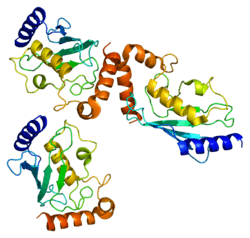UBE2E3
Ubiquitin-conjugating enzyme E2 E3 is a protein that in humans is encoded by the UBE2E3 gene.[5][6]
The modification of proteins with ubiquitin is an important cellular mechanism for targeting abnormal or short-lived proteins for degradation. Ubiquitination involves at least three classes of enzymes: ubiquitin-activating enzymes, or E1s, ubiquitin-conjugating enzymes, or E2s, and ubiquitin-protein ligases, or E3s. This gene encodes a member of the E2 ubiquitin-conjugating enzyme family. The encoded protein shares 100% sequence identity with the mouse and rat counterparts, which indicates that this enzyme is highly conserved in eukaryotes. Two alternatively spliced transcript variants encoding the same protein have been found for this gene.[6]
References
- 1 2 3 GRCh38: Ensembl release 89: ENSG00000170035 - Ensembl, May 2017
- 1 2 3 GRCm38: Ensembl release 89: ENSMUSG00000027011 - Ensembl, May 2017
- ↑ "Human PubMed Reference:".
- ↑ "Mouse PubMed Reference:".
- ↑ Ito K, Kato S, Matsuda Y, Kimura M, Okano Y (Jun 1999). "cDNA cloning, characterization, and chromosome mapping of UBE2E3 (alias UbcH9), encoding an N-terminally extended human ubiquitin-conjugating enzyme". Cytogenet Cell Genet. 84 (1–2): 99–104. doi:10.1159/000015229. PMID 10343118.
- 1 2 "Entrez Gene: UBE2E3 ubiquitin-conjugating enzyme E2E 3 (UBC4/5 homolog, yeast)".
Further reading
- Hay RT, Vuillard L, Desterro JM, Rodriguez MS (2000). "Control of NF-kappa B transcriptional activation by signal induced proteolysis of I kappa B alpha". Philos. Trans. R. Soc. Lond. B Biol. Sci. 354 (1389): 1601–9. doi:10.1098/rstb.1999.0504. PMC 1692667. PMID 10582246.
- Desterro JM, Thomson J, Hay RT (1998). "Ubch9 conjugates SUMO but not ubiquitin". FEBS Lett. 417 (3): 297–300. doi:10.1016/S0014-5793(97)01305-7. PMID 9409737.
- Desterro JM, Rodriguez MS, Hay RT (1998). "SUMO-1 modification of IkappaBalpha inhibits NF-kappaB activation". Mol. Cell. 2 (2): 233–9. doi:10.1016/S1097-2765(00)80133-1. PMID 9734360.
- Desterro JM, Rodriguez MS, Kemp GD, Hay RT (1999). "Identification of the enzyme required for activation of the small ubiquitin-like protein SUMO-1". J. Biol. Chem. 274 (15): 10618–24. doi:10.1074/jbc.274.15.10618. PMID 10187858.
- Zhang QH, Ye M, Wu XY, et al. (2001). "Cloning and functional analysis of cDNAs with open reading frames for 300 previously undefined genes expressed in CD34+ hematopoietic stem/progenitor cells". Genome Res. 10 (10): 1546–60. doi:10.1101/gr.140200. PMC 310934. PMID 11042152.
- Pringa E, Martinez-Noel G, Muller U, Harbers K (2001). "Interaction of the ring finger-related U-box motif of a nuclear dot protein with ubiquitin-conjugating enzymes". J. Biol. Chem. 276 (22): 19617–23. doi:10.1074/jbc.M100192200. PMID 11274149.
- Ito K, Adachi S, Iwakami R, et al. (2001). "N-Terminally extended human ubiquitin-conjugating enzymes (E2s) mediate the ubiquitination of RING-finger proteins, ARA54 and RNF8". Eur. J. Biochem. 268 (9): 2725–32. doi:10.1046/j.1432-1327.2001.02169.x. PMID 11322894.
- Plafker SM, Macara IG (2002). "Ribosomal protein L12 uses a distinct nuclear import pathway mediated by importin 11". Mol. Cell. Biol. 22 (4): 1266–75. doi:10.1128/MCB.22.4.1266-1275.2002. PMC 134630. PMID 11809816.
- Strausberg RL, Feingold EA, Grouse LH, et al. (2003). "Generation and initial analysis of more than 15,000 full-length human and mouse cDNA sequences". Proc. Natl. Acad. Sci. U.S.A. 99 (26): 16899–903. doi:10.1073/pnas.242603899. PMC 139241. PMID 12477932.
- Lehner B, Semple JI, Brown SE, et al. (2004). "Analysis of a high-throughput yeast two-hybrid system and its use to predict the function of intracellular proteins encoded within the human MHC class III region". Genomics. 83 (1): 153–67. doi:10.1016/S0888-7543(03)00235-0. PMID 14667819.
- Beausoleil SA, Jedrychowski M, Schwartz D, et al. (2004). "Large-scale characterization of HeLa cell nuclear phosphoproteins". Proc. Natl. Acad. Sci. U.S.A. 101 (33): 12130–5. doi:10.1073/pnas.0404720101. PMC 514446. PMID 15302935.
- Gerhard DS, Wagner L, Feingold EA, et al. (2004). "The status, quality, and expansion of the NIH full-length cDNA project: the Mammalian Gene Collection (MGC)". Genome Res. 14 (10B): 2121–7. doi:10.1101/gr.2596504. PMC 528928. PMID 15489334.
- Plafker SM, Plafker KS, Weissman AM, Macara IG (2005). "Ubiquitin charging of human class III ubiquitin-conjugating enzymes triggers their nuclear import". J. Cell Biol. 167 (4): 649–59. doi:10.1083/jcb.200406001. PMC 2172591. PMID 15545318.
- Barrios-Rodiles M, Brown KR, Ozdamar B, et al. (2005). "High-throughput mapping of a dynamic signaling network in mammalian cells". Science. 307 (5715): 1621–5. doi:10.1126/science.1105776. PMID 15761153.
- Hillier LW, Graves TA, Fulton RS, et al. (2005). "Generation and annotation of the DNA sequences of human chromosomes 2 and 4". Nature. 434 (7034): 724–31. doi:10.1038/nature03466. PMID 15815621.
- Rual JF, Venkatesan K, Hao T, et al. (2005). "Towards a proteome-scale map of the human protein-protein interaction network". Nature. 437 (7062): 1173–8. doi:10.1038/nature04209. PMID 16189514.
- Lim J, Hao T, Shaw C, et al. (2006). "A protein-protein interaction network for human inherited ataxias and disorders of Purkinje cell degeneration". Cell. 125 (4): 801–14. doi:10.1016/j.cell.2006.03.032. PMID 16713569.






